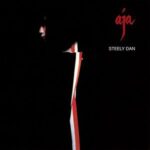 Some albums in your collection, however important they are musically, take on an importance in your life that goes way beyond some sounds coming out of boxes in the corner. Sometimes an album worms its way through your defences to connect up with all sorts of other parts of life and, before you know it, the songs have become inextricably entangled with memories of friends, family and lovers; and there’s no way of untying those knots. “Aja” is one of those albums for me; it has mellow memories of my student years, memories of friends met along the way and tragic memories of one of those friends taken when she had everything before her.
Some albums in your collection, however important they are musically, take on an importance in your life that goes way beyond some sounds coming out of boxes in the corner. Sometimes an album worms its way through your defences to connect up with all sorts of other parts of life and, before you know it, the songs have become inextricably entangled with memories of friends, family and lovers; and there’s no way of untying those knots. “Aja” is one of those albums for me; it has mellow memories of my student years, memories of friends met along the way and tragic memories of one of those friends taken when she had everything before her.
“Aja” was released in October 1977 and the timing was perfect for me. It was the start of my second year at Uni and I’d escaped from halls into a flat where I shared a room with a mate from my first year. We were both musicheads, both played guitar after a fashion and I had a reasonably good stereo. It’s fair to say there was music playing from the moment one of us woke up until the last head (usually mine) hit the pillow. I had a well-paid summer job (which I could tell you a few stories about), so I hit Dundee every October with plenty of readies to support the local record shops.
I was already a bit of a Steely Dan fan, so “Aja” was a no-brainer for me. As I listened to it end-to-end for the first time, I read the lyrics, the list of musicians involved on each track (which I now realise was a guide to the best session guys in the world at that time) and the sleeve notes written by Michael Phalen after spending some fraught and unprofitable time with Becker and Fagen trying to extract some sensible contributions. Typical of their contributions was the description of “Peg” as a ‘pantonal thirteen blues with chorus’; luckily Michael wasn’t a guy to bear a grudge.
It was a strange time for a band like Steely Dan; they were the antithesis of the punk philosophy. I loved the energy of punk/new wave/power pop but I wasn’t willing to take the slash and burn attitude to older music (it cost me a fortune to buy this stuff, no bloody way was I just ditching it). The album took an age to make, the playing was exquisite and there were only seven tracks, none of them less than four minutes long. Just compare that to a Ramones album with fourteen songs, none much more than two minutes long (and I loved The Ramones as well), but “Aja” was about pure musical class, cryptic and coded lyrics with a seedy undertone and some outrageously good solo playing. I didn’t realise at the time that I’d bought a jazz album.
And talking of jazz, that was exactly the kind of cigarettes that accompanied listening to “Aja” for my university years; it was the perfect match, mostly laid-back arrangements, lots of space and perfect to chill out to. It was one of half a dozen albums that always found their way to the deck over the next three years, however many new albums I bought. I wasn’t even choosy about picking favourites; there are seven tracks, “Black Cow”, “Aja”, “Deacon Blues”, “Peg”, “Home at Last”, “I Got the News” and “Josie” and they’re all stunningly good. I would happily listen to any of those songs at any time. But the university idyll couldn’t last forever and I settled back in with my family for a while after graduation. It was the beginning of the Thatcher era and I was living in Mansfield; it was obviously going to be grim, or so I thought.
I settled into a temporary job and listened to a lot of depressing post-punk until something very strange happened. On the regular Friday night out, a mate suggested a visit to The Red Lion, a fun pub (think sleazy, cheesy and very camp) that had just taken off. I was hooked, and after the second visit I landed a weekend bar job there. If the memoirs ever come together, there’s a chapter there that might need very careful legal scrutiny. And that’s where I met Gill (beautiful with a razor-sharp wit) and her friend Denise, both nurses doing part-time bar work. Within a few weeks, we’d all decided to share a house together on Woodhouse Road with another friend, Andy, and I was living a student life again.
I brought one important thing to the party; my record collection. Within a few days, Gill had discovered “Aja” and I realised I would never really own the album again. As much as I loved you Gill, I have to say you absolutely trashed that album; fingerprints all over the first track on each side, and the album never, ever went back in its sleeve. Did it matter? No it didn’t, because she loved the album with such a passion I couldn’t get angry about it. It wasn’t unusual to walk in and find Gill in her underwear ironing that night’s outfit while listening to “Aja” (we always popped a head round the living room door before inviting guests in). We were great mates anyway, but this album was something that created an everlasting bond. While we shared that house, we both formed the relationships that defined our lives (and a few that didn’t); and “Aja” was always there in the background.
Life moved on, the way it does in your early twenties when you think you’ll live forever, and we all left the house to move in with our various partners but kept in touch, directly or on the grapevine as we moved in our chosen directions. Gill started a successful business, fell in love with a nice guy and they had three beautiful daughters. I drifted through nightclub and pub management, the dole queue and self-employment and finally, in 1992, landed a job in entertainments for the armed forces. It was great news and I was all ready to make a new start on a residential training course. Everything was good; and then the doorbell rang.
Denise was on the doorstep, in tears. Gill wasn’t with us any more; she’d had a massive brain haemorrhage a few days before while out shopping and her life support had just been switched off. It wasn’t the first time I’d had to deal with a sudden death (from the other side of the doorstep), but this was someone I’d lived with, and loved, and I thought would always be a part of my life. She had a loving husband and three daughters under five and she had gone, forever. Because of the new job two hundred miles away, I couldn’t get to the funeral (an older me would say ‘Fuck the new job’), so I had to be represented. I still miss Gill to this day; she was the kind of person that took up a huge space in your life and there was a huge hole when she left.
And what was left? Well, I still love “Aja”, and every time I listen to the album, particularly the vinyl version that still has all of the marks and noises left by Gill, I remember that beautiful person ironing in her bra and knickers and singing along to “Peg” at the top of her voice.
And there’s a postscript to this story. On October 30th 2017, I finally got to see Steely Dan live on a double bill with The Doobie Brothers at the 02. The band, as you would expect, was absolutely superb, but the atmosphere was slightly muted because of the death, less than two months before, of Walter Becker. A few gallons of silent tears were shed that night, but mine didn’t really have anything to do with mourning Walter Becker.
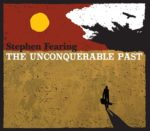 Stephen Fearing’s thirteenth solo album’s very personal and, at the same time it’s also political, but this isn’t just one for the social theorists because those elements are inextricably linked with the musical settings for the songs. Three of the songs on the album are named for people and there’s a strong vein of nostalgia running through the lyrical and musical stylings of “The Unconquerable Past”, although this isn’t by any means wallowing in the past; it’s much more of a realisation that there’s always a danger of dismissing older musical styles as no longer relevant in the headlong rush to be on-trend. It’s not a new thing, those wonderful old cynics Becker and Fagen nailed it in their own beautifully sleazy way in “Hey Nineteen” in 1980: ‘Hey, nineteen, that’s ‘Retha Franklin, she don’t remember the Queen of Soul’.
Stephen Fearing’s thirteenth solo album’s very personal and, at the same time it’s also political, but this isn’t just one for the social theorists because those elements are inextricably linked with the musical settings for the songs. Three of the songs on the album are named for people and there’s a strong vein of nostalgia running through the lyrical and musical stylings of “The Unconquerable Past”, although this isn’t by any means wallowing in the past; it’s much more of a realisation that there’s always a danger of dismissing older musical styles as no longer relevant in the headlong rush to be on-trend. It’s not a new thing, those wonderful old cynics Becker and Fagen nailed it in their own beautifully sleazy way in “Hey Nineteen” in 1980: ‘Hey, nineteen, that’s ‘Retha Franklin, she don’t remember the Queen of Soul’.
To come back to Stephen Fearing, this album is a bit of a departure from his solo material in that, at times, there’s a full rock band behind some uptempo tunes, one of which, “Christine”, goes way back to classic rockabilly styling and it’s a lot of fun. The other notably uptempo song, “Stay with Me” has its roots firmly in drivetime rock that Bob Seger seemed to knock out for fun in the late seventies.
If there’s one theme above all others pulling the album together it’s empathy, particularly where people with differences are dealing with harsh and unforgiving society we live in today. “Sunny” is a great example as the story is gradually revealed of a transgender individual leaving home to eventually find a relationship that works. The writer isn’t judging, and preaches the same tolerance in “Someone Else’s Shoes”; we should always try to understand the pressures someone else is facing rather than rushing to condemn.
Personal highlights are the poignant “Emigrant Song”, co-written with Andy White, dealing with the conflicting tensions of moving and looking back at happy memories, and the title song, with the message that we are products of our past but we don’t have to be defined by it. The album closes out with “No Country”, a solo acoustic ballad that positions the troubadour as a citizen of nowhere at all.
“The Unconquerable Past” is a collection of ten high-calibre songs performed with quality and taste that will make you tap your feet and make you stop and think. Not a bad combination.
“The Unconquerable Past” is out in the UK now in various physical and digital formats of Fish Records (FRCD03).
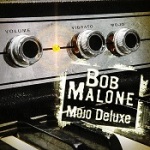 You would never guess that “Mojo Deluxe” is Bob Malone’s seventh album; granted it’s packed with the kind of accomplished playing, tipping over into virtuosity, that you would expect from seasoned players, but there’s a vitality and freshness here that wouldn’t be out of place on a debut album. There’s another magic ingredient as well; fun. There’s the odd studio comment left in on an intro or outro, but it’s more than that; this album sounds like people having a good time; the kind of fun you have when you’re doing what you do best, with a bunch of musicians who are tuned in to what you do.
You would never guess that “Mojo Deluxe” is Bob Malone’s seventh album; granted it’s packed with the kind of accomplished playing, tipping over into virtuosity, that you would expect from seasoned players, but there’s a vitality and freshness here that wouldn’t be out of place on a debut album. There’s another magic ingredient as well; fun. There’s the odd studio comment left in on an intro or outro, but it’s more than that; this album sounds like people having a good time; the kind of fun you have when you’re doing what you do best, with a bunch of musicians who are tuned in to what you do.
Just like the “Mojo EP”, a sampler for the album released in the UK a year ago, “Mojo Deluxe” kicks open the doors with an electric piano riff and pounding bass on “A Certain Distance” that say ‘Go on, just try and ignore me’. Don’t even try; just surrender to the rhythm and enjoy the ride. You might be willing to forgive a jaw-droppingly good keyboard player with a classic gravelly blues voice if he just phoned in some lyrics to fit the great tunes but, guess what, Bob Malone has that covered as well. “A Certain Distance”, “I’m Not Fine” and “Rage and Cigarettes” all tap into the malaise that afflicts gifted musicians confined with others like themselves on tour; you’re locked into a dysfunctional world where you come to hate your travelling companions, but you hate outsiders even more. It’s not as snarky as Donald Fagen, but then what is?
But, there’s more to life than snark. “Paris” is a gentle love song, overturning the clichés with the message that Paris is all very well, but doesn’t mean anything if your lover’s somewhere else; there’s even the irony of an accordion solo. “Toxic Love” is a love song in its own brooding, menacing way with slide dobro and sinister hissing vocal; it’s an affair you wouldn’t expect to turn out too well. There’s a couple of blues covers as well, the Ray Charles classic “Hard Times”, which gets a very clean modern workout with a punchy guitar solo, and a lo-fi, piano-led version of Muddy Waters’ “She Moves Me”. The instrumental, “Chinese Algebra” is a demonstration of Bob’s piano technique which works equally well with the band arrangement or the solo version that you can find all over YouTube; it’s another one of those bits of fun that spice up the album.
“Looking for the Blues” and “Don’t Threaten Me (With a Good Time)” are both uptempo blues numbers with all the trimmings including horns and backing vocals (even a funky clavinet on “Don’t Threaten Me…”); great fun again. “Watching Over Me” and “Can’t Get There from Here” both have a world-weary gospel feel and bring the album to a satisfactory if slightly melancholy close. And that’s it for “Mojo Deluxe”; it’s an enticing stew of Muddy Waters, Ray Charles, Dr John and mainly Bob Malone. Once you’ve tried it, you’ll be coming back for more.
Bob will be touring the UK with his superb band later this year. Go and see him at any of these venues and see what all the fuss is all about:
Friday October 9 The Railway Hotel, Southend-on-Sea
Saturday October 10 Boogaloo Blues Weekend, Yarmouth, Isle of Wight
Sunday October 11 The Navy Club, Maryport
Wednesday October 14 Dusty’s Blues Club, High Wycombe
Thursday October 15 The Green Hotel, Kinross
Friday October 16 The Blue Lamp, Aberdeen
Sunday October 18 Hope Tavern, West Lindsey
Tuesday October 20 Blues Café, Harrogate
Wednesday October 21 Railway Venue, Bromley Cross, Bolton
Thursday October 22 The Jam House, Birmingham
Friday October 23 Keighley Blues Club
Saturday October 24 Catholic Club, Peterlee
Monday October 26 The Bullingdon (Haven Club), Oxford
Tuesday October 27 The 100 Club, London
Wednesday October 28 The Jazz Café, Cardiff
“Mojo Deluxe” is released on August 21.
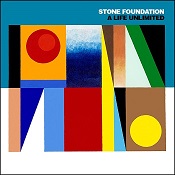 It’s always a good feeling when a band or artist you like starts to get a bit of recognition, particularly when you know they’ve put in the hard hours over a long period of time and they’re doing something that they believe in and they’re committed to body and soul. In 2014, things were finally starting to happen for Stone Foundation. After years of serious graft with no industry backing, playing support slots, organising their own tours and self-funding their releases, people started to take notice and they got a bit of radio exposure (Craig Charles helped a bit there). They did support tours with The Selecter and The Blow Monkeys and the album “To Find the Spirit” made a dent in the independent charts; even The Modfather was photographed holding a copy. So, where to next?
It’s always a good feeling when a band or artist you like starts to get a bit of recognition, particularly when you know they’ve put in the hard hours over a long period of time and they’re doing something that they believe in and they’re committed to body and soul. In 2014, things were finally starting to happen for Stone Foundation. After years of serious graft with no industry backing, playing support slots, organising their own tours and self-funding their releases, people started to take notice and they got a bit of radio exposure (Craig Charles helped a bit there). They did support tours with The Selecter and The Blow Monkeys and the album “To Find the Spirit” made a dent in the independent charts; even The Modfather was photographed holding a copy. So, where to next?
Well, the next album, “A Life Unlimited”, is out on August 7th, so that’s a pretty good place to start. It would have been so easy to stick with the style that made “To Find the Spirit” successful, but that’s not what these guys do; the new album was always going to move in a slightly different direction, particularly after a few of the personnel changes that are almost inevitable in a large group.
The opening song, “Beverley”, (the theme tune from Alexander Thomas’ short film of the same name) is a tantalising hint as to the slight change of direction. It could almost be a track from the previous album, apart from the congas (courtesy of new member Rob Newton), which infuse a little Latin spirit into the funky cocktail of horns, Hammond and wah-wah guitars. There’s a change of emphasis in the brass section as well; Gareth John filled the trumpet vacancy last year and Adam Stevens has come in on baritone sax to replace trombonist Spencer Hague while he takes a break, both joining long-standing tenor saxophonist Gary Rollins. It gives the brass section a more Stax/Atlantic feel with a greater focus on ensemble playing as opposed to solos. It’s a philosophy which applies to the band generally; Stone Foundation is about eight guys working together to create gorgeous grooves and it works because the egos are reined in and the band is more important than the individual.
The sumptuous ballad “Pushing Your Love”, with harmonies from The Four Perfections, wouldn’t have sounded out of place on the previous album, while “Something in the Light” takes a little step forward with the brass section, particularly Adam Stevens’ baritone lines, generating a Memphis Horns feel and the Q Strings adding a touch of velvet to the sting of brass. And that’s all before the Van Morrison-style breakdown with strings, tenor sax and backing vocals from The Four Perfections and Janet and Samantha Harris. Lovely stuff.
“The Turnaround” and “Learning the Hard Way” are real departures for the band. The horn fills have a New York/Cuban feel which weave around Neil Sheasby’s bubbling bass lines and Neil Jones’ guitar to create a sound which is much more New York fusion than small town soul; the kind of thing Southside Johnny and his brass section The New York Horns have been doing so well recently. They’re both irresistibly funky.
It’s the two centre pieces (or the last track on side one and the first on side two if you’re going for the vinyl) which give the clearest indication of the new influences on this album; there’s a bit of jazz in the mix. “Speak Your Piece” is a sprawling epic of a song which starts with handclaps, a piano motif (which is picked up later by the horns) and a five-note bass riff which runs through the song. Even as the song builds and layers are added, there’s always plenty of space in the mix; it never feels crowded as it builds up to a noisy chorus and drops back to piano and bass under the lead before building up again to big horn-driven finale. There’s even a one-note piano solo from Ian Arnold, and if that isn’t jazz, I don’t know what is. “The Night Teller” has a mid-tempo cool jazz feel evoking the cover artwork of Donald Fagen’s classic “The Nightfly” album and features a guest vocal by Graham Parker underpinned by some understated baritone sax. It’s all beautifully played and GP’s vocal works perfectly as a complement to the voice of Neil Jones. “These Life Stories” is a mid-tempo groove built around some laconic brass ensemble playing and delicate electric piano and it’s another example of the ‘less is more’ philosophy; you don’t need flash when a band can play this well together. Even the conga solo is politely restrained.
“A Love Uprising”, the album’s penultimate track, opens up like a 1990 house tune with a simple piano riff and Philip Ford’s four-to-floor kick drum but, within a few bars congas come in to soften the beat before seventies hi-hats and funk guitar, and then brass fills morph the piece into classic New York disco. And who’s that coming in just before two minutes with a rap? It’s Dr Robert from The Blow Monkeys making a guest appearance. Just to add to the Studio 54 ambience, you even get congas and disco whistles; it’s so authentic they knocked back Nile Rodgers when he tried to get in to the session. The closing track “Old Partners, New Dances” is an instrumental piece featuring Ian Arnold on piano and Gareth John on flugel horn, evoking the feel of a jazz club at four in the morning and it’s perfect way to bring the album down for a soft landing after the manic buzz of “A Love Uprising”.
Since the sessions for “A Life Unlimited”, the band has signed record deals in Japan (with P-Vine Records) and the USA (with Spectra Music Group); things definitely aren’t standing still at the moment and, with this album, they probably have the right set of songs to break through. What shines through every aspect of the album is quality; the songs are well-crafted, the arrangements are sensitive and varied and the performances are all superb. Even the artwork by Horace Panter (you are going to buy it on CD or vinyl, aren’t you?) is spot on. Maybe “A Life Unlimited” proves that, in a world where a Glastonbury headliner gets away with out-of-tune karaoke, there’s still room for music created with passion and talent.
“A Life Unlimited” is released on August 7/ 2015.
 “Meanwhile” – Part Time Heroes
“Meanwhile” – Part Time Heroes
Whilst this is completely new to me and probably the best album I’ve heard in 2014, it actually got released back in 2008 but pretty much passed everyone by. I first heard the track “Shadowlands” on Jamie Cullum’s Jazz show that airs on Radio 2; my ears pricked up immediately and I instantly sought out the album, which is a gem, not a duff track on it. They use various vocalists and it certainly has a contemporary jazzy feel to it but I also hear echoes of Terry Callier and lots of other stuff going on. It’s destined to be one of those lost classics, certainly worth investigating for sure.
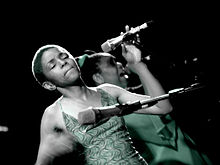 Carleen Anderson at Ronnie Scott’s
Carleen Anderson at Ronnie Scott’s
I didn’t get to as many gigs as I would have liked to this year due to Stone Foundation’s hectic schedule throughout 2014. The one that really stood out head & shoulders above everything else I saw this year was Carleen Anderson’s performance at Ronnie Scott’s at the start of the year. She is (still) such an underrated talent with an exceptional vocal range, obviously we (Stone foundation) were very fortunate to have Carleen grace our last album where she contributed an amazing vocal to one of our songs called “When You’re in My World“. She is an amazing songwriter and arranger too; her new material is just outstanding, as good as anything she has ever written and I really hope it sees the light of day sometime soon. It was an inspiring evening and one that will stay with me.
 “Eminent Hipsters” – Donald Fagen
“Eminent Hipsters” – Donald Fagen
I’ve been reading a lot this year, much more so than usual, I have no idea why, perhaps I have been looking for inspiration to kick start my own scribblings again; I’m 12 chapters in to my first book but kind of stalled once again really due to other commitments but I hope to pick up the trail again come the new year and get it finished. This book by Steely Dan main man Donald Fagen was a real treat, his words danced from the pages. It covers all the cool hipster characters that influenced his own inevitable style, it also covers his late college years in New York where he first met Walter Becker his co-founder and musical partner in Steely Dan. It’s a very funny book too, especially in the latter chapters when documenting his time on tour recently with Boz Scaggs & Michael Mcdonald. It brings to life the up’s and down of the anxieties and indignities of life on the road in the most brilliantly humorous way.
This year I rediscovered the joys of the radio. A couple of programmes in particular really inspired me. Ana Matronic’s Disco show that aired on Friday nights for six weeks on Radio 2 was a real winner; she didn’t so much play obvious disco musak in the sense of the naff, cliched sound you would imagine but focussed on the real grooves of that period such as the influential Salsoul sound and some of the orchestral arrangements that people like Barry White popularized with Love Unlimited and also the wonderful world of Gamble & Huff and that whole Philly thing. It introduced me to a lot of new stuff that I hadn’t heard previously like Francine McGee’s “Delirium”; I also ended up buying the whole works, a box set of Philly stuff. Don Letts’ show on 6 Music has also turned me on to a lot of new music too; only last night I heard something by Jaga Jazzist called “Made for Radio” that had my attention from the off. I think it’s great to know that there is still some really thoughtful radio still being aired and made; long may it continue. It’s how I first got inspired, by listening to Peel on a transistor in my bedroom when I should have been doing my homework; I guess in many ways I was………
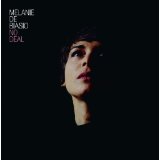 “Space is the Place” – Yusef Lateef / Melanie De Biasio “No Deal”
“Space is the Place” – Yusef Lateef / Melanie De Biasio “No Deal”
I’ve been gravitating towards a more jazzy sound over the past couple of years. I’ve kind of not lost interest but put Guitar / Rock music on the back burner for a while; it’s not what I want to inform me when it comes to my own writing at the moment. I’m more pre occupied with space in arrangements; this Yusef Lateef track kind of personifies that mind set. I’ve heard a lot of great new music too this year but mainly in a pop vein like the Jessie Ware album & that Jungle single “Busy Earnin'” which I really liked. Also one of my favourite new albums and discoveries of this year has been the Melanie De Biasio album “No Deal…”; she is a classically trained flautist from Belgium who has a tremendous voice too. It’s a great record and one that also exemplifies my love of space in the music. It’s not in a hurry to impress; it creeps up on you. In saying all of this I must admit that I was impressed with Ryan Adams’ spectacular return to form on his last (self-titled) LP; the production and sound of it is incredible. It sounds like “Rumours” which is a tough task to pull off.
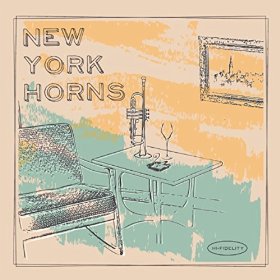 It’s relatively easy to record an album these days; you can do it at home or maybe in a studio and it won’t cost you the earth. You can organise your own distribution online or at live shows; you won’t get rich but you will get some return for your creativity. Not everything released by this route is good; there are way too many vanity projects, but occasionally something really worthwhile emerges. Sometimes a group of talented and like-minded musicians get together and just play the tunes they really want to play. If it makes a few dollars, that’s fine, but that’s not really the point because the musicians are playing the music they want to play and having a bit of fun with their own original material and a few covers. Very, very occasionally the result is an album packed with, superb performances and arrangements that you want to listen to again and again. “New York Horns” is one of those.
It’s relatively easy to record an album these days; you can do it at home or maybe in a studio and it won’t cost you the earth. You can organise your own distribution online or at live shows; you won’t get rich but you will get some return for your creativity. Not everything released by this route is good; there are way too many vanity projects, but occasionally something really worthwhile emerges. Sometimes a group of talented and like-minded musicians get together and just play the tunes they really want to play. If it makes a few dollars, that’s fine, but that’s not really the point because the musicians are playing the music they want to play and having a bit of fun with their own original material and a few covers. Very, very occasionally the result is an album packed with, superb performances and arrangements that you want to listen to again and again. “New York Horns” is one of those.
So, who are the New York Horns? Well the horn players are Chris Anderson (trumpet and flugelhorn), John Isley (tenor and baritone sax and bass clarinet) and Neal Pawley (trombone and vocals) and they’re better known as the horn section of Southside Johnny the Asbury Jukes. Here they’re aided and abetted by fellow-Jukes Jeff Kazee (piano, Hammond B3, keys and vocals) and Glenn Alexander(guitars, dobro, mandolin and vocals) and a rhythm section of Shawn Pelton (drums and percussion) and Tony Tino (electric bass).
The album opens with a very different instrumental take on KT Tunstall’s breakthrough song “Black Horse & the Cherry Tree”. Where the original builds gradually by using a loop pedal for instrumental and vocal parts, the NYH version comes in, after a quick guitar intro, at full strength with Latin American percussion (courtesy of Marc Quinones) and perhaps a hint of early Santana. Chris Anderson’s tone poem “Morningside at Midnight” is next, taken at a walking tempo, and evoking the spirit of Morningside Heights with electric piano, wah-wah guitar and unison sax and trumpet. The Hank Williams classic “Hey Good Lookin’” is the first vocal piece, driven along by a guitar riff and horn fills before the sax, guitar and Hammond solos kick in. “Song for Levon”, a Chris Anderson and John isley co-write is a tribute to Levon Helm. It’s stately and mournful in classic New Orleans tradition and features Southside Johnny as guest harmonica player.
The uptempo jazz-funk of John Isley’s “Little Miss Thing” wouldn’t sound out of place on either of Donald Fagen’s first two solo albums and features the first trombone solo on the album from Neal Pawley; it’s great fun. “Can’t Stand to See You Cry”, written and sung by Jeff Kazee, is a powerful soul song with a superb plaintive vocal and an arrangement that Allen Toussaint would be proud of while “Strollin’ With Sean” is a fairly straightforward blues driven along by a horn riff and it’s another chance for the guys to solo for all they’re worth and have a great time. The final cover on the album is John Hiatt’s “Little Head” which retains the feel of the original while adding punch with horn fills.
John Isley’s “78 Below” opens with an uptempo Nile Rodgers –style lead/rhythm riff which, with the punchy bass, drives the piece along underneath a staccato muted trumpet melody before the mood mellows again with Chris Anderson’s “More Than Tears”. Opening with a restrained combination of piano, acoustic guitar and mandolin, this moody and melancholic piece is perfect for the flugelhorn which Chris uses to carry the main melody. John Isley’s “Under the Hood” is an atmospheric piece using Hammond and the horn ensemble to create the mood and features a muted trumpet solo from Chris Anderson. The album’s closing song, “Nothing Left to Say”, opens slowly in New Orleans jazz funeral style, with a guest vocal by Christine Ohlman before erupting just before the halfway mark into uptempo New Orleans jazz with trumpet and sax counterpoint. There’s also a lyrical message here which underpins the whole album; however bad things get, there’s always music to pull you back, whether you play it or listen to it. It’s a perfect way to close the album.
The beauty of this album is that it was made because the musicians involved really wanted to make it. They had a lot of ideas and they wanted to get those ideas out there to people who might want to hear them. It’s not about focus groups or marketing teams; it’s about strong, sometimes very personal, material arranged well and played superbly. If you need to label it, I suppose it’s jazz, but it also pushes out in other directions as well, towards funk and old school soul; there’s certainly plenty of variety on display. Check out some of the song links here and think seriously about buying yourself a copy, if only to let a bunch of great musicians know that some people out there are actually getting the message.
Available now from Amazon and iTunes.
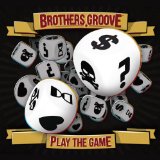 How about that? Less than a month into 2014 and I’ve just heard my first great album of the year; it’s by Brothers Groove, it’s their debut and it’s called “Play the Game”. So what’s so great about this album then? All of the songs are well-crafted, but the quality of the playing and the vocals push it way beyond run-of-the-mill British blues. If you want to see how the band describe their influences, you can look at their website, but it’s only going to tell you part of the story; you can list the influences (and you can hear them from the first play), but the craft lies in the way those elements are blended together subtly and tastefully.
How about that? Less than a month into 2014 and I’ve just heard my first great album of the year; it’s by Brothers Groove, it’s their debut and it’s called “Play the Game”. So what’s so great about this album then? All of the songs are well-crafted, but the quality of the playing and the vocals push it way beyond run-of-the-mill British blues. If you want to see how the band describe their influences, you can look at their website, but it’s only going to tell you part of the story; you can list the influences (and you can hear them from the first play), but the craft lies in the way those elements are blended together subtly and tastefully.
The beating heart of Brothers Groove is the interplay between Shaun Hill (guitar, vocals and main lyricist), Nigel Mellor (guitar and vocals) and Deano (bass and vocals). On this album, they’re helped out by Wayne Proctor (drums and production), Bob Fridzema (keyboards), Bennett Holland (piano) and Sam Weeks (backing vocals), but the creative focus of the band is definitely the interplay between guitars and bass.
The band move effortlessly between the crisp funk of “Play the Game (Save your Soul)”, “What’s the Deal” and “Understand Me” (which wouldn’t sound out of place on either of Donald Fagen’s first two solo albums) and the slow, brooding blues of “Treat ‘em Mean”, “Another Girl” and “Will I See you There?” And there’s the jazz-funk of “My Guitar” (a love song about a guitar), the psychedelic feel of “Never Gonna Happen”, the shuffle groove of “Duty Calls” and the soulful “Easy Found Love”, held together by some tasteful Hammond chords and featuring a typically understated wah-wah guitar solo.
This is an album that doesn’t rely on big production techniques or guitar pyrotechnics to get the message over; it’s all about superb technical playing where the two guitars mesh perfectly in a way I haven’t heard since listening to Onnie McIntyre and Hamish Stuart of the Average White Band. The resemblance doesn’t end there, either; the lead vocal sounds uncannily like Alan Gorrie at times and I’m definitely not saying that’s a bad thing. Brothers Groove as players are so good that they make intricate inter-woven arrangements sound incredibly simple; they aren’t, it’s down to ability and dedication. They have the confidence to play without pushing everything to the limit; the quality of the songs and the individual players’ techniques ensure that nothing sounds forced, from the opening guitar riff of the title track to ripple of Fender Rhodes at the end of “Will I see you there?”. To complete the picture, lead and backing vocals are spot on throughout; I can’t find anything to dislike about this album.
The members of the band have obvious influences, but these are woven into the pattern so cleverly that they create something that’s fresh and contemporary. Imagine Steely Dan without the snarky sarcasm or the Average White band without the horns and you’re pretty much there.
Out now on Shabby Toad Records (BRGROOV1). Distributed by Cadiz Digital.
Ok, call me obsessive if you like but as well as listening to a lot of albums and going to as many gigs as I can, I also read the odd book or two about music and popular culture and many of those are worth sharing with anyone who checks out MusicRiot regularly. This list was difficult to pin down to five from the start, but it became even more difficult on Christmas Day when I was given a copy of the Donald Fagen memoir/tour diary/article compilation, “Eminent Hipsters”. So I guess that’s a pretty good place to start.
“Eminent Hipsters” – Donald Fagen
 Where do I start with Donald Fagen? With Walter Becker, he was half of one of my favourite 70s bands, Steely Dan and then went on to release the classic solo album, “The Nightfly” in 1982, followed (not too closely) by “The Kamakiriad” in 1993. You’ve probably guessed by now, I’m a bit of a fan. “Eminent Hipsters” is partly an explanation, through a series of articles, of the factors which influenced the Steely Dan sound (cool jazz, cop dramas and wise-ass comedians) and the Donald Fagen solo sound (science fiction and mid-century paranoia). If you love the music, you’ll be fascinated by these observations about its roots. The second part of this slim volume is devoted to Fagen’s diary from the 2012 “Dukes of September Rhythm Revue” tour which is, by turn, snarky, moving, insightful and downright hilarious.
Where do I start with Donald Fagen? With Walter Becker, he was half of one of my favourite 70s bands, Steely Dan and then went on to release the classic solo album, “The Nightfly” in 1982, followed (not too closely) by “The Kamakiriad” in 1993. You’ve probably guessed by now, I’m a bit of a fan. “Eminent Hipsters” is partly an explanation, through a series of articles, of the factors which influenced the Steely Dan sound (cool jazz, cop dramas and wise-ass comedians) and the Donald Fagen solo sound (science fiction and mid-century paranoia). If you love the music, you’ll be fascinated by these observations about its roots. The second part of this slim volume is devoted to Fagen’s diary from the 2012 “Dukes of September Rhythm Revue” tour which is, by turn, snarky, moving, insightful and downright hilarious.
Donald Fagen writes in an instantly-identifiable style betraying a debt to Raymond Chandler and Dashiell Hammett, which sneaks in when describing Audrey Hepburn in “Breakfast at Tiffany’s” as getting :”out of that cab on Fifth Avenue in a black dress and pearls in the early morning, I wanted to sip her through a straw”. It’s beautifully written and you can get through it in a few hours; it takes 170 pages to deliver a message that most rock biographies take at least five times as long to get over.
“Bedsit Disco Queen: How I Grew Up and Tried to be a Pop Star” – Tracey Thorn
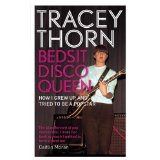 If Donald Fagen’s prose style is easily identifiable, then Tracey Thorn’s is even more so. I’m always impressed when musicians get this right (Peter Hook and Luke Haines also do it particularly well) and, from the first paragraph, this is pitch-perfect ‘Popstar Trace’. The book takes us from the Marine Girls beginnings through the EBTG false starts and eventual success to the beautiful Massive Attack vocals (I’m biased, but you should read about the origins of the modern classic, “Protection” here) and the worldwide Todd Terry-remixed success of “Missing”.
If Donald Fagen’s prose style is easily identifiable, then Tracey Thorn’s is even more so. I’m always impressed when musicians get this right (Peter Hook and Luke Haines also do it particularly well) and, from the first paragraph, this is pitch-perfect ‘Popstar Trace’. The book takes us from the Marine Girls beginnings through the EBTG false starts and eventual success to the beautiful Massive Attack vocals (I’m biased, but you should read about the origins of the modern classic, “Protection” here) and the worldwide Todd Terry-remixed success of “Missing”.
Tracey’s style is perfectly self-deprecatory; you never feel a hint of false modesty and the mentions of famous musicians are always very matter-of-fact, including the story about waiting to pick the kids up from school and being shouted at by George Michael from a Range Rover. This is a wonderful memoir from a genuine pop star.
“Yeah, Yeah, Yeah: The Story of Modern Pop” – Bob Stanley
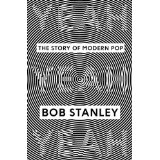 It’s obvious from the outset that this is actually a companion piece to the classic 2012 St Etienne album, “Words and Music”. The album was a voyage through the history of British pop music and the book is an extended verbal remix of the ground covered by the album. What’s equally obvious is that Bob Stanley is both an enthusiast and an insider, which gives him a unique perspective on his subject. He aims to show the links between different styles using not just the music, but also sociological and technological developments. If you’re interested in the history of pop music and you’ve done a bit of research, you might disagree with some of his pronouncements, but it’s a big book and you’ll probably agree with ninety per cent of them.
It’s obvious from the outset that this is actually a companion piece to the classic 2012 St Etienne album, “Words and Music”. The album was a voyage through the history of British pop music and the book is an extended verbal remix of the ground covered by the album. What’s equally obvious is that Bob Stanley is both an enthusiast and an insider, which gives him a unique perspective on his subject. He aims to show the links between different styles using not just the music, but also sociological and technological developments. If you’re interested in the history of pop music and you’ve done a bit of research, you might disagree with some of his pronouncements, but it’s a big book and you’ll probably agree with ninety per cent of them.
The book takes the first NME chart in 1952 as its starting point (which is logical and not controversial) and the end of vinyl as a chart force in 1993 as its end point, when the first Number One singles not to have been released as a 7” single or (a few months later) on vinyl at all topped the charts (if you want to know what they are, you can buy the book ). It’s a slightly more controversial choice but still with a logical basis for someone who grew up in the age of vinyl. The book has an authority derived from Bob Stanley’s experience as a writer and member of a very successful pop group but never slips into the socio-cultural academic approach of, for example, Simon Reynolds. The theme that underpins everything else in this book is that Bob Stanley is still a fan who wants you to come round and listen to his records, and that makes this an unmissable book.
“Here Comes Everybody: The Story of the Pogues” – James Fearnley
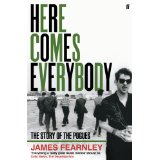 I’ve always been a fan of the “inside story” biography, particularly those that aren’t ghost-written attempts at cultural revisionism. This memoir by James Fearnley is, at times, brutally and crushingly honest about members of The Pogues and he doesn’t spare himself either. The book begins by setting the scene with Shane MacGowan’s departure from the band in 1991 before moving back to Fearnley’s initial meeting with MacGowan at an audition for The Nips in 1980.
I’ve always been a fan of the “inside story” biography, particularly those that aren’t ghost-written attempts at cultural revisionism. This memoir by James Fearnley is, at times, brutally and crushingly honest about members of The Pogues and he doesn’t spare himself either. The book begins by setting the scene with Shane MacGowan’s departure from the band in 1991 before moving back to Fearnley’s initial meeting with MacGowan at an audition for The Nips in 1980.
The book is a (mainly) unsentimental account of the rise and fall of The Pogues from the viewpoint of someone close enough to see everything but with enough distance to retain some objectivity. From the chaotic managerless beginnings through the unpopular but successful stewardship of Frank Murray, the story is underpinned at all times by MacGowan’s unpredictability and seemingly random self-destructive urges. James Fearnley tries very hard to balance the singer’s inexcusable behaviour against the genius of the songs, but it’s up to you if you buy that line; I certainly don’t. My only criticism is that James Fearnley spends a little too much time trying to emphasise the fact that he’s a writer and occasionally introduces unnecessarily florid prose to prove it; putting that aside, it’s still a winner.
“Sounds like London: 100 Years of Black Music in the Capital” – Lloyd Bradley
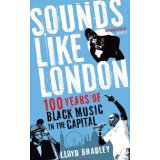 Bear with me for a minute here; this will all make sense presently. Earlier this year I read “How Soon is Now?: The Madmen and the Mavericks who made Independent Music 1975-2005” by Richard King. It’s a very good book and a must for geeks like us, but it attracted a lot of criticism because it didn’t touch on the black music scene. Richard King was even accused, pathetically, of racism in some quarters; you might even have read about it. Personally, I prefer to read authors who write about subjects they understand and that really inspire them; if Richard King didn’t have the expertise, contacts or inspiration to write about the black music scene, then Lloyd Bradley certainly did.
Bear with me for a minute here; this will all make sense presently. Earlier this year I read “How Soon is Now?: The Madmen and the Mavericks who made Independent Music 1975-2005” by Richard King. It’s a very good book and a must for geeks like us, but it attracted a lot of criticism because it didn’t touch on the black music scene. Richard King was even accused, pathetically, of racism in some quarters; you might even have read about it. Personally, I prefer to read authors who write about subjects they understand and that really inspire them; if Richard King didn’t have the expertise, contacts or inspiration to write about the black music scene, then Lloyd Bradley certainly did.
The title is a little misleading; there’s very little about pre-1950s black music, and it also deals with regional English offshoots from the London scene but those aren’t criticisms, just observations. The reason for the comparison with Richard King’s book is that one of Lloyd Bradley’s recurring themes is that black British music has always developed and prospered healthily out of the mainstream when produced and distributed independently.
Once the book reaches the point where Lloyd Bradley can introduce interviews with the players who made black British music happen (the steel pan players, the jazzers, the sound system pioneers, the Britfunk players and the mainstream crossovers Eddy Grant, Janet Kay, Jazzie B and the rest), the narrative really takes off with stories of the sound systems and records being sold out of the back of a car and distributed around the country in the same way. Lloyd Bradley takes us through calypso, ska, reggae, lovers rock, dub, britfunk, 98 bpm, trip hop, jungle, d’n’b, UK garage, dubstep and grime along with a host of short-lived one-way streets with an unassuming and easy authority that is very seductive. If you want an introduction to black British music, this is the book for you.
OK, spoilers alert; I’ve relented. I’ll tell you that the chart-toppers Bob Stanley refers to in 1993 and 1995 respectively are Culture Beat’s “Mr Vain” and Celine Dion’s “Think Twice”, but you should still read the book. Actually you should read all of these books.



